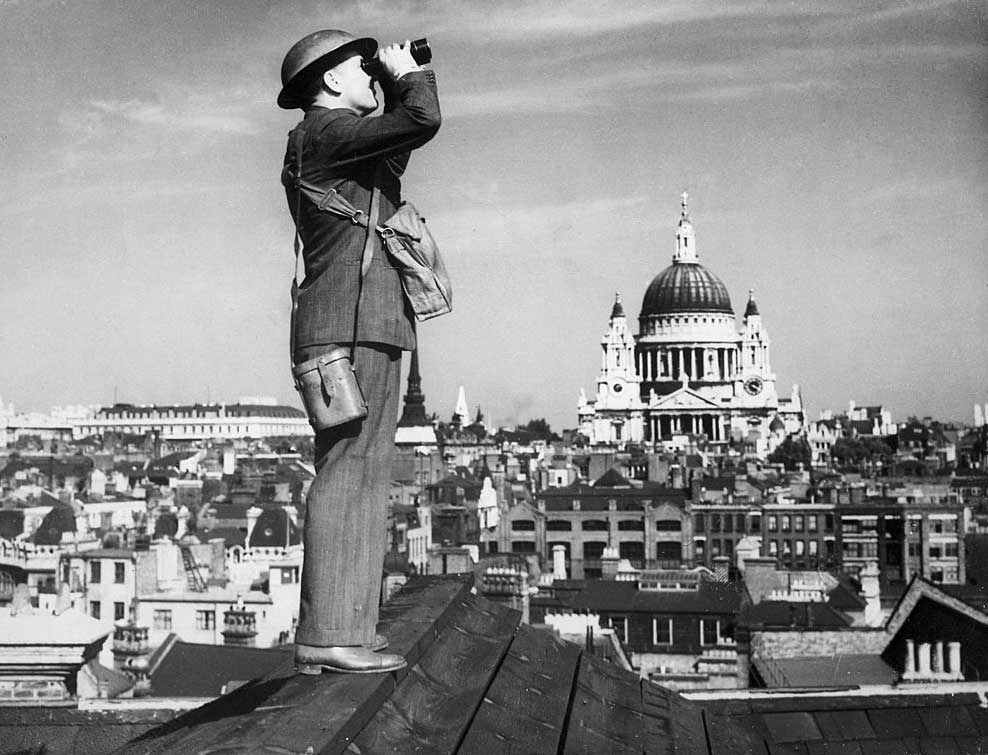July 1 to October 30th 1940 Battle of Britain

Air Observor in London
The Germans attempted to subdue Great Britain by utilizing air attacks. Germany attacked all major cities and military installations. British preparedness, combined with the valor of its pilots and a new weapon called "radar," forced the Germans to pay a heavy price for their bombing. By the end of October, when the winter weather made the threat of invasion unlikely, the Germans had lost 1,268 planes, compared to 832 British planes lost.
With France defeated, Germany shifted its focus to England, which Hitler anticipated would initiate a peace negotiation. An invasion of Britain presented a formidable challenge, necessitating both maritime and aerial dominance, neither of which Germany possessed. Despite these obstacles, Hitler ordered the commencement of preparations for the invasion under the codename Operation Sealion. Simultaneously, on July 16, 1940, he issued Fuhrer Directive (No. 16), which mandated the Luftwaffe to seize control of the air, eliminate all naval vessels in potential landing zones, dismantle coastal defenses, and annihilate reserves behind enemy lines. The Battle of Britain was poised to commence.
Each faction possessed distinct advantages. The British commenced with 1,900 aircraft, while the Germans had 2,550. Although the Germans possessed a larger pilot contingent, the British maintained a superior rate of aircraft production. Furthermore, the British possessed a crucial advantage: radar stations strategically positioned along the Channel coast, which were integrated into a highly efficient command and control system. This system enabled the British air force to direct aircraft to intercept incoming German planes. Lastly, the German aircraft had to traverse a distance of 100 miles to reach their target, whereas the British could ascend to combat altitude with relative ease. Additionally, British pilots possessed the capability to return to the cockpit within a day after a bailout, whereas German pilots would be captured as prisoners of war.
The initial phase of the conflict commenced on July 10th with assaults on the coastal towns of Weymouth, Falmouth, Portsmouth, and Dover. This initial phase persisted until July 30th, during which period 180 German aircraft were destroyed, in contrast to the loss of 70 British fighters. Notably, 100 of the German planes destroyed were bombers, resulting in an approximately equal exchange ratio between the two sides in terms of fighter aircraft. The Germans successfully sank 40,000 tons of merchant vessels, but no substantial naval vessels were lost.
On August 1st, Hitler initiated a shift in strategy, with the objective of eliminating the Royal Air Force (RAF). Initially, the RAF appeared to possess a tactical advantage. However, on August 13th, the first day of the engagement, the RAF suffered a loss of 13 aircraft while defending a Spitfire factory, while the German losses amounted to 45. Gradually, however, the relentless German attacks were systematically compromising both radar stations, damaging factories, and airfields.
The gradual advancements made by the Luftwaffe were insufficient for Hitler’s ambitions. Recognizing the imminent closure of his window of opportunity to attack England, he ordered a shift in the focus of his attacks to London, with the objective of instilling terror in the British populace and compelling them to surrender. The British capital was robustly defended, equipped with 1,500 barrage balloons, 2,000 anti-aircraft guns, and a substantial portion of the British fighter force prepared to mobilize for defense.
For a ten-day period, the German onslaught commenced. On September 15th, the most formidable German force yet assembled, comprising 200 bombers, embarked on a mission towards London. Fighter command skillfully redirected fighters from various regions of England to intercept the German bombers east of London. Remarkably, they successfully shot down 60 of the bombers before they could even reach the vicinity of London. This pivotal event underscored the futility of the German attacks in achieving their objective of breaching the British defenses.
On September 17th, Hitler made the decision to postpone the Sealion operation. Daylight raids persisted throughout September, followed by a shift towards less precise nighttime bombing by the Luftwaffe. This nocturnal bombardment, often referred to as the classic Blitz of London, instilled fear among the civilian population. While it was a defining feature of the conflict, it proved to be an ineffective weapon of war.
The Battle of Britain had been decisively won by 2,500 British and foreign airmen. Winston Churchill’s poignant statement, “Never had so many owed so much to so few,” aptly encapsulated the significance of this victory. In total, the Royal Air Force (RAF) fighter command suffered a loss of 832 fighters, while the Luftwaffe incurred a loss of 668 fighters. However, the Luftwaffe also suffered an additional 600 bombers, underscoring the immense toll of the conflict.
 >
>